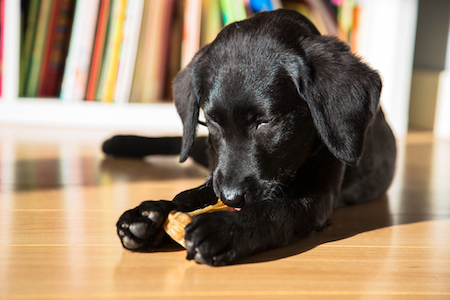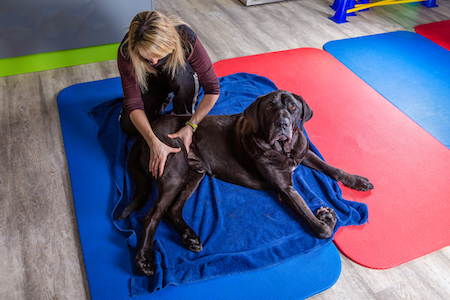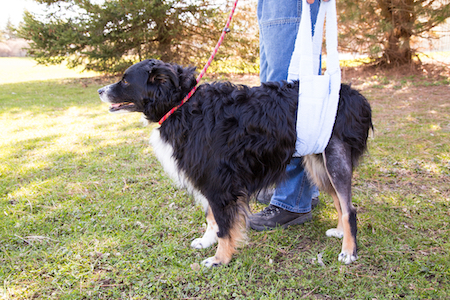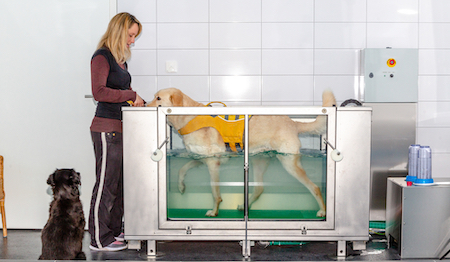Knuckling in Dogs
Posted: 07/02/2022 | BY: Erin Cain | Categories: Dog , Health problems , Pet care
If you’ve ever seen a dog knuckle under while walking, you know how heartbreaking it can be. This condition, also known as knuckling over or toe-walking, can cause dogs to lose their balance and impairs their mobility. In severe cases, paw knuckling can even lead to paralysis. This article will discuss what causes knuckling in dogs and the various treatment options available to pup parents.

What is knuckling in dogs?
Dog knuckling refers to when a dog walks or rests on top of his feet instead of his paws. This condition can occur in the front paws, rear paws, and more than one paw; however, it rarely occurs in all four feet at once. Knuckling under is not an ideal position for a dog to be in, and it is uncomfortable and sometimes painful. It restricts dogs from doing many things efficiently, the most apparent being running or walking.
Paw knuckling is a condition that can happen for various reasons. Some of the most common ones include nerve damage and neurological disorders. Regardless of the cause, call his vet immediately if you notice your dog knuckling his paws.
This action causes the foot to tuck under and drag against the ground, which will cause additional injuries to the foot if not treated quickly. The repetition of this movement leads to permanent damage and impacts your dog’s gait for the remainder of his life. Also, knuckling can indicate that other medical issues are affecting your pup, some of which may have life-threatening implications.

How can you tell if your dog is knuckling?
Your dog’s gait can give you a good indication of whether or not he is knuckling. This condition causes unsteadiness or an uneven gait when your dog is walking.
First, pick up each of your dog’s paws one at a time. Then, set it down with the knuckle under. If your dog does not correct the position of the tucked foot, he probably has a knuckling issue. Contact your veterinarian and tell them about your dog’s knuckles. They will recommend you make an appointment for your dog as soon as possible.
What causes knuckling in dogs?
Knuckling is a sign of many different ailments or a potentially more dangerous disease or illness. Here are some of the common causes of knuckling in dogs:
Arthritis
Knuckling is a sign that your dog may be experiencing the pain and stiffness associated with arthritis. If it becomes too uncomfortable for them to walk, some dogs will knuckle to relieve pressure on certain joints. The signs of arthritis are not limited to older dogs. Younger dogs can also develop the condition, especially if they live in bad conditions or have a poor diet that causes inflammation throughout their body.
If you have a dog suffering from arthritis, the best thing to do is treat his symptoms. You can gently exercise him, give him joint supplements, treat him with prescribed pain medications, feed him a quality diet, or apply compresses on painful areas.
Carpal flexural deformity
Factors such as rapid growth spurts in large breed puppies can cause carpal flexural deformity. This condition causes the wrist joint to bulge, forcing the paw to knuckle under. Limiting the puppy’s exercise and placing a temporary cast on his leg will help ensure that the pup grows more accordingly to his size and shape. With the leg splint or cast, the dog’s growth and development should continue properly without further concern.
Physical therapy exercises are an essential part of the treatment process. Your vet may also perform surgery to fuse your puppy’s joint into its proper position. Knuckling with carpal flexural deformity occurs most frequently in large breed dogs such as German shepherds, Dobermans, and giant breed puppies, like Great Danes.
Degenerative myelopathy
Knuckling in older dogs can signify degenerative myelopathy, a condition sometimes paired with arthritis. Degenerative myelopathy thins cartilage in the spinal cord. Over time, this thinning of white matter leads to neural malfunctions that eventually lead to weakness in the hind limbs and paralysis. During this process, the weak limbs will knuckle under, and the dog will experience wobbliness and other coordination and mobility issues.
Degenerative myelopathy is an incurable disease. Veterinarians can treat this condition with medications that target symptoms, gentle exercise, joint supplements, warm climates, and dietary changes to limit the dog’s exposure to inflammation.

Fibrocartilaginous embolism
A fibrocartilaginous embolism (FCE) occurs when fibrous cartilage obstructs the blood supply through a part of your dog’s arteries and veins. The result is an embolism, or a spinal stroke, in the spinal cord. The obstruction is usually a part of the spinal bone that breaks away from the cord and stops blood flow to an area of the dog’s body.
This condition can be incredibly frightening for dogs. It causes a section of their spinal cord to die, and they cannot control or feel the affected limb. They will experience varying degrees of paralysis from this point on.
FCE typically affects large and giant breed dogs and happens when sudden trauma occurs during exercise. Knuckling is only one side effect of FCE. However, with appropriate pain management and physical therapy, you can retrain your dog to walk normally on the affected leg and reverse the knuckling process.
Intervertebral disc disease (IDD)
Intervertebral disc disease (IDD) is a spinal disorder caused by a slipped, bulging, or ruptured disk. Commonly seen in large breed dogs and older dogs, intervertebral disc disease occurs when the discs between the spinal cord vertebrae begin to deteriorate. When these discs become injured, they allow bones of the back to rub against each other, pushing on nerves and leading to severe complications, including inflammation.
Knuckling is a telltale sign of IDD, as is stumbling, lack of coordination, back arching, and stiffness. IDD can be successfully treated with anti-inflammatory medications and steroids. In some rare cases, surgical intervention may be necessary.
Tumors
Although uncommon, knuckling is a side effect of tumors that grow in areas where they press upon parts of the spinal cord or nerves around the spinal cord. This condition can occur when either benign or cancerous tumors are present.
Generally, the removal of the tumor resolves the knuckling associated with this issue. If the tumor is in a location that makes surgery risky, discuss the benefits and drawbacks of proceeding with your veterinarian.

How to treat knuckling in dogs
Knuckling is a condition that affects a dog’s mobility and gait. Still, treatment depends on what caused your dog to develop this disorder. Some cases may require surgery, while others can only be managed with supportive care.
Knuckling can be caused by several different factors which may require one or more of the following medical treatment and lifestyle changes to fix the problem:
- gentle exercise
- improved diet
- added supplements
- acupuncture
- hyperbaric oxygen therapy
- wrapping
- laser therapy
- anti-inflammatory medical management
- physical therapy, including underwater treadmill exercise
- physical rehabilitation
- surgery
- a foot brace and bootie
- mobility aids, such as a specialized harness
- no knuckling training sock
- toe grips
- sling or dorsiflexion assist
- progressive resistance bands
- cage or crate rest
Knuckling in dogs is scary, but it doesn’t mean your dog’s quality of life is forever altered. Suppose your puppy develops knuckling and is quickly treated. In that case, your dog is 100% likely to recover.
If you have an older dog showing signs of knuckling, the best thing to do is have them examined by a vet to diagnose any additional medical concerns. Otherwise, keep them comfortable and exercised, and feed them an appropriate diet with high-quality joint supplements.

Treat knuckling in dogs with the help of pet insurance.
Knuckling in dogs accompanies many other medical conditions and diseases, and the costs of treatments add up fast. Unfortunately, recovering from knuckling is time-consuming, and your dog’s vet bills will only increase along the way.
Don’t worry about how to fund your pup’s treatments. Get a free quote for a pet insurance policy that will reimburse you up to 90% of veterinary costs. Let Pet Insurance Review find the best providers with plans that serve your dog’s needs and fit your budget.
References:
- Packer, S. (2020). Carpal Laxity Syndrome aka Knuckling Over in Puppies. Retrieved from https://www.balanced-canine.com/post/carpal-laxity-syndrome-aka-knuckling-over-in-puppies
- Kruzer, A. (2022). Degenerative Myelopathy in Dogs. Retrieved from https://www.thesprucepets.com/the-stages-of-degenerative-myelopathy-3384548
- Williams, K., Downing, R. (2022). Fibrocartilaginous Embolus/Emboli (FCE) in Dogs. Retrieved from https://vcahospitals.com/know-your-pet/fibrocartilaginous-embolusemboli-fce-in-dogs
- Carolina Veterinary Specialists Matthews. (2022). Symptoms of Intervertebral Disc Disease (IVDD) in Dogs & Available Treatments. Retrieved from https://www.matthews.carolinavet.com/site/pet-health-blog/2020/08/14/ivdd-intervertebral-disc-disease-in-dogs
- Northwest Austin Veterinary Center. (2020). Knuckling in Puppies: Causes & Ways to Help Your Puppy. Retrieved from https://www.nwaustinveterinarycenter.com/site/blog/2022/05/17/knuckling-puppies
- Vital Vet. (2022). Devices for Pets with Knuckling or Dragging Paws. Retrieved from https://vitalvet.org/blogs/news/what-aids-are-available-for-dogs-with-dragging-or-knuckling-paws
The information contained on this blog is intended for informational and educational purposes only and should not be construed as medical advice. It is not a substitute for professional veterinary care. Always consult with your veterinarian before making any changes to your pet's health care or treatment plan.
The authors of this blog are not veterinarians and do not claim to be experts in pet health. The information provided here is based on our own experiences and research, as well as information from reputable sources. However, we cannot guarantee the accuracy or completeness of this information.
We encourage you to do your own research and consult with your veterinarian before making any decisions about your pet's health.
Previous post
Why Sharp Sounds Trigger Seizures in CatsNext post
7 Signs Your Dog is in PainCompare top pet insurance providers plans.
Enter your dog’s age in years and months to calculate their age equivalent to human years.
Calculate your dog’s ageEnter your cat’s age in years and months to calculate their age equivalent to human years.
Calculate your cat’s age